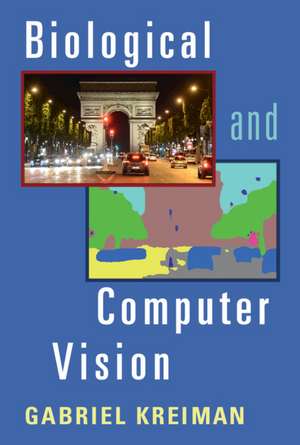Biological and Computer Vision
Autor Gabriel Kreimanen Limba Engleză Hardback – 3 feb 2021
| Toate formatele și edițiile | Preț | Express |
|---|---|---|
| Paperback (1) | 375.09 lei 6-8 săpt. | |
| Cambridge University Press – 3 feb 2021 | 375.09 lei 6-8 săpt. | |
| Hardback (1) | 782.83 lei 6-8 săpt. | |
| Cambridge University Press – 3 feb 2021 | 782.83 lei 6-8 săpt. |
Preț: 782.83 lei
Preț vechi: 910.27 lei
-14% Nou
Puncte Express: 1174
Preț estimativ în valută:
149.81€ • 154.56$ • 126.79£
149.81€ • 154.56$ • 126.79£
Carte tipărită la comandă
Livrare economică 05-19 martie
Preluare comenzi: 021 569.72.76
Specificații
ISBN-13: 9781108483438
ISBN-10: 1108483437
Pagini: 280
Dimensiuni: 180 x 250 x 20 mm
Greutate: 0.64 kg
Editura: Cambridge University Press
Colecția Cambridge University Press
Locul publicării:New York, United States
ISBN-10: 1108483437
Pagini: 280
Dimensiuni: 180 x 250 x 20 mm
Greutate: 0.64 kg
Editura: Cambridge University Press
Colecția Cambridge University Press
Locul publicării:New York, United States
Cuprins
1. Introduction to the world of vision; 2. The travels of a photon – natural image statistics and the retina; 3. The phenomenology of seeing; 4. Creating and altering visual percepts through lesions and electrical stimulation; 5. Adventures in terra incognita: probing the neural circuits along the ventral visual stream; 6. From the highest echelons of visual processing to cognition; 7. Neurobiologically plausible computational models; 8. Teaching computers how to see; 9. Towards a world with intelligent machines that can interpret the visual world; 10. Visual consciousness.
Recenzii
'… an interesting analysis of computational modeling for visual consciousness. Impressive in scope, the book is brief, resulting in a text that is quite approachable … Highly recommended.' J. M. Carroll, Choice
Notă biografică
Descriere
This book introduces neural mechanisms of biological vision and how artificial intelligence algorithms learn to interpret images.
